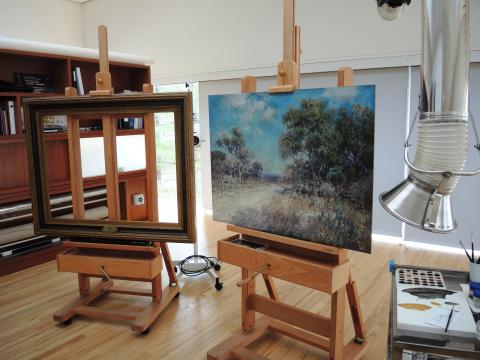Work by Texas Artist Julian Onderdonk Recently Restored in the DMA’s Painting Conservation Studio
-- “Road to the Hills” Will go on View for the First Time in More Than 60 years --

Dallas, TX – August 24, 2015 – The painting Road to the Hills by famed Texas artist Julian Onderdonk has been newly restored in the DMA’s Paintings Conservation Studio. Considered a masterpiece of early 20th-century Texas art, the painting will go on view tomorrow in the Museum’s American art galleries on Level 4 after an absence of 60 years.
Purchased in 1919 by the Dallas Shakespeare Club and donated to the Museum in that same year, Road to the Hills, c. 1918, was created at the height of the artist’s career. The painting depicts the bright, reflective light of the midday sun on an isolated white road in the Texas Hill Country, which, according to DMA Chief Conservator Mark Leonard, signifies “a tour-de-force departure from the theme of the bluebonnet, and, consequently, reveals the wider range of the artist.” In a delightful turn of fate, the current members of the Dallas Shakespeare Club provided support for the conservation of Onderdonk’s work with a $25,000 gift, bringing this link to the Museum into a new century.
Conservation on Road to the Hills included treatment to the canvas, original frame, and restoration from previous conservation efforts. The work, originally painted on a canvas, sustained extensive flaking problems, and in its initial restoration, most likely in the late 1950s, the original canvas was exchanged for Masonite, or fiberboard. Unfortunately, the transfer of the painting from canvas to the paneling did not prevent continued flaking; Leonard’s treatment addressed this and other age-related issues without the need to retransfer the canvas, and he undertook a complete cleaning of the painting’s surface.
During his short life, Julian Onderdonk (1882–1922) transformed the Texas landscape, creating indelible images of the Lone Star State. One of William Merritt Chase's most dazzling students at the Shinnecock Summer School on Long Island, Onderdonk brought Chase's aesthetic of nature to an entirely new part of the American landscape. By his death at age 40, Onderdonk had been christened "The Bluebonnet Painter," in recognition of the success of his lush signature landscapes of fields of the state flower. In 2008, the DMA presented Bluebonnets and Beyond: Julian Onderdonk, American Impressionist, an exhibition of more than 90 paintings that offered the first critical re-examination of one of early Texas’s most important painters.
About the Paintings Conservation Studio
The Paintings Conservation Studio at the Dallas Museum of Art opened in 2013 as part of the Museum’s initiative to establish a more comprehensive in-house conservation program. The Paintings Conservation Studio features state-of-the-art technology—including a digital X-ray system—and serves as a center for study and treatment of works of art as well as research into cutting-edge conservation methodologies. An adjoining gallery regularly rotates works of art, providing a space for visitors to explore the conservation process in greater detail through visual representations.
Image: Julian Onderdonk’s Road to the Hills post conservation in the DMA’s Paintings Conservation Studio, April 2015 (Julian Onderdonk, Road to the Hills, c. 1918, oil on canvas, Dallas Museum of Art, gift of the Dallas Shakespeare Club in memory of Elizabeth Patterson Kiest, 1919.2)
About the Dallas Museum of Art
Established in 1903, the Dallas Museum of Art (DMA) is among the 10 largest art museums in the country and is distinguished by its commitment to research, innovation, and public engagement. At the heart of the Museum and its programs is its global collection, which encompasses more than 23,000 works and spans 5,000 years of history, representing a full range of world cultures. Located in the nation’s largest arts district, the Museum acts as a catalyst for community creativity, engaging people of all ages and backgrounds with a diverse spectrum of programming, from exhibitions and lectures to concerts, literary events, and dramatic and dance presentations. Since the Museum’s return to free general admission in 2013, the DMA has welcomed more than two million visitors, and enrolled more than 100,000 people in DMA Friends, the nation’s first free museum membership program. For more information, visit DMA.org.
The Dallas Museum of Art is supported, in part, by the generosity of DMA members and donors, the citizens of Dallas through the City of Dallas Office of Cultural Affairs, and the Texas Commission on the Arts.